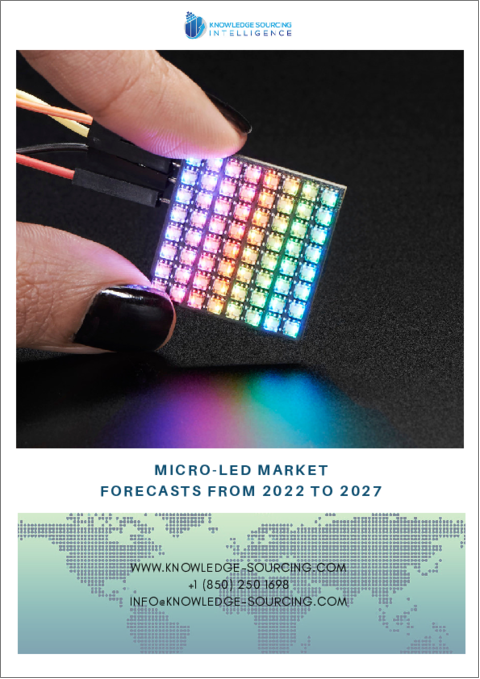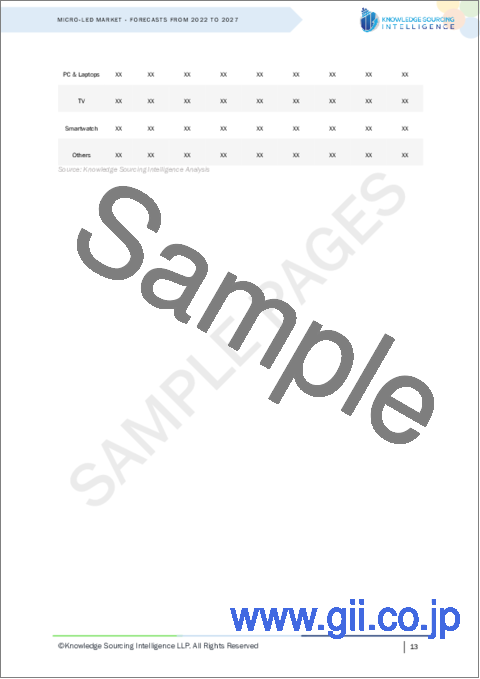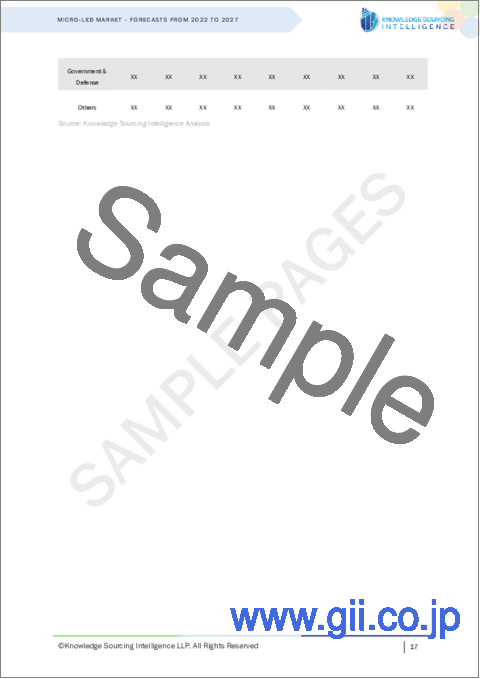|
|
市場調査レポート
商品コード
1087051
マイクロLEDの世界市場予測(2022年~2027年)Micro LED Market - Forecasts from 2022 to 2027 |
||||||
|
● お客様のご希望に応じて、既存データの加工や未掲載情報(例:国別セグメント)の追加などの対応が可能です。 詳細はお問い合わせください。 |
|||||||
| マイクロLEDの世界市場予測(2022年~2027年) |
|
出版日: 2022年04月28日
発行: Knowledge Sourcing Intelligence
ページ情報: 英文 116 Pages
納期: 即日から翌営業日
|
- 全表示
- 概要
- 目次
世界のマイクロLEDの市場規模は、2020年の3億7,731万6,000米ドルから、2027年には431億5,870万4,000米ドルに達し、予測期間中に96.81%のCAGRで成長が予測されています。
マイクロLEDは、他の技術よりも消費電力が少ないため、さらに需要を押し上げる見通しです。また、可処分所得の増加や人々の生活水準の変化に伴い、デジタル製品の需要も年々増大すると予測されます。スマートフォンやノートパソコン、スマートウォッチ、テレビなどのデバイスがより良くアップグレードされることで、マイクロLEDのような技術の需要にとって有利な状況となります。
当レポートでは、世界のマイクロLED市場について調査分析し、市場概要、市場力学、市場分析、競合情勢、企業プロファイルなど、体系的な情報を提供しています。
目次
第1章 イントロダクション
- 市場の定義
- 市場セグメンテーション
第2章 調査手法
- 調査データ
- 前提条件
第3章 エグゼクティブサマリー
- 調査のハイライト
第4章 市場力学
- 市場促進要因
- 市場抑制要因
- ポーターのファイブフォース分析
- 供給業者の交渉力
- 買い手の交渉力
- 新規参入業者の脅威
- 代替品の脅威
- 業界における競争企業間の敵対関係
- 業界バリューチェーン分析
第5章 マイクロLED市場分析:製品タイプ別
- イントロダクション
- スマートフォン・タブレット
- PC・ノートパソコン
- テレビ
- スマートウォッチ
- その他
第6章 マイクロLED市場分析:業界別
- イントロダクション
- 家庭用電化製品
- 自動車
- 政府・防衛
- その他
第7章 マイクロLED市場分析:ディスプレイサイズ別
- イントロダクション
- マイクロパネル
- 小型・中型パネル
- 大型パネル
第8章 マイクロLED市場分析:用途別
- イントロダクション
- ディスプレイ
- 照明
第9章 マイクロLED市場分析:地域別
- イントロダクション
- 北米
- 米国
- カナダ
- メキシコ
- 南米
- ブラジル
- アルゼンチン
- その他
- 欧州
- 英国
- ドイツ
- フランス
- その他
- 中東・アフリカ
- アラブ首長国連邦
- 南アフリカ
- イスラエル
- サウジアラビア
- その他
- アジア太平洋
- 中国
- 日本
- インド
- オーストラリア
- 台湾
- 韓国
- その他
第10章 競合環境と分析
- 主要企業と戦略分析
- 新興企業と市場収益性
- 合併・買収・合意・提携
- ベンダーの競合マトリクス
第11章 企業プロファイル
- Samsung Electronics Co. Ltd.
- LG Electronics, Inc.
- PlayNitride Inc.
- Sony Group Corporation
- X-Celeprint Limited
- Innolux Corporation
- Epistar Corporation
- Aledia
- VueReal Inc.
The Micro-LED market is expected to grow at a compound annual growth rate of 96.81% over the forecast period to reach a market size of US$43,158.704 million in 2027, from US$377.316 million in 2020.
Micro-LED is an emerging display technology that aims to provide a flat panel display with a wide viewing angle, quick response time, and a simultaneous reduction of energy consumption compared to existing technologies. Micro-LED provides a better display and higher brightness than LCD and OLED, and other existing technologies. This is expected to increase its popularity and application in devices like TVs, smartwatch, tablet, laptops, PCs, and others. Micro-LED consumes less power than other technologies, which is expected to boost its demand further. Also, with the rising disposable income and changing living standards of the people, the demand for digital products is expected to increase over the years. With better up-gradation in devices like smartphones, laptops, smartwatches, TVs, etc., the demand for technologies like micro-LED stands at a favorable position.
One of the major restraints to this market is the high investment cost and high product price, which can not only affect the entry of new companies in this field but can also hamper the demand from customers owing to the high price associated with the product. Apart from that, the existing technologies are projected to serve as significant competition, especially in terms of affordability to the market, impacting its growth.
Growth Factors
- Demand for high display options
With the rise in development and urbanization across the globe, the factors like disposable income and living standards are being affected. Over the years, trends suggest that people have increased their demand for high-tech products to adjust to automation and technological advancement and simultaneously produce better results for their businesses. Therefore, the ever-rising demand and our growing dependence on high display digital products like smartwatches, TVs, laptops, etc., along with better display results than LCDs and OLEDs, are projected to fuel the demand for micro-LEDs in the coming years.
- Low power consumption by micro-LEDs
The major highlight of micro-LED products is that they consume less power than other existing technologies, which are expected to give a considerable market share to this market in the years to come. This is because of micro-LED's color filters and backlights, and with the advancement in this developing technology, the number of polarizer filters in them is expected to be cut in half, which can further reduce its energy consumption.
- North America is expected to hold a significant share
Based on geographical segmentation, the micro-LED market is segmented into North America, South America, Asia Pacific, the Middle East and Africa, and Europe. Of these, North America is expected to hold a significant share in the market owing to the various factors like high scale adoption of technological advancement in the region, the high disposable income of the people, which can fuel the demand for expensive technologies like micro-LED, growing demand for smartwatches, smartphones, etc. For instance, Apple Inc., an American Company, is expanding its expertise in micro-LED and may soon launch some products under the domain. In 2020 the company was looking to invest around $330 million in a Taiwanese factory to manufacture LED and micro-LED displays for future iPhones, iPads, MacBooks, and other devices. Apart from that, major functioning companies under micro-LED technology like VueReal, etc., are already located here, providing a major advantage to the region.
Apart from this APAC region is expected to grow at the highest rate owing to the rising digital transformation accompanied by the presence of major players like Epistar Corporation, Sony Corporation, Samsung Electronics, etc., in the region.
Restraints
- High cost and competition from substitutes like LCDs and OLEDs
One of the major restraints for the micro-LED market is the high cost associated with the development and purchase of this product. As of now, not many market players have been able to adopt this technology due to the high initial investment in this project. This is expected to restrain its growth to some extent as the entry of new players can get impacted severely.
Apart from that, being a developing and advancing technology, the price associated with micro-LED products is still high compared to its substitutes like LCDs and OLEDs. This can restrain common citizens and middle-class people from buying this luxury, and the availability of affordable substitutes can create tough competition for this market and hinder its growth in the future.
Impact of COVID-19 pandemic on the micro-LED market:
With the onset of the COVID pandemic around the globe, the market for micro-LED suffered negatively. Due to the shift in focus of the people on necessities, the demand for luxuries like smartphones, smartwatches, TVs, etc., reduced, which severely hampered the micro-LED market.
Market Segmentation:
- By Product Type
Smartphone & Tablet
PC & laptop
TV
Smartwatch
Others
- By Industry Vertical
Consumer Electronics
Automotive
Government & Defense
Others
- By Display Size
Micro Panel
Small and Medium Panel
Large Panel
- By Application
Display
Lighting
- By Geography
North America
- USA
- Canada
- Mexico
South America
- Brazil
- Argentina
- Others
Europe
- U.K.
- Germany
- France
- Others
Middle East and Africa
- UAE
- South Africa
- Israel
- Saudi Arabia
- Others
Asia-Pacific
- China
- Japan
- India
- Australia
- Taiwan
- South Korea
- Others
TABLE OF CONTENTS
1. INTRODUCTION
- 1.1. Market Definition
- 1.2. Market Segmentation
2. RESEARCH METHODOLOGY
- 2.1. Research Data
- 2.2. Assumptions
3. EXECUTIVE SUMMARY
- 3.1. Research Highlights
4. MARKET DYNAMICS
- 4.1. Market Drivers
- 4.2. Market Restraints
- 4.3. Porters Five Forces Analysis
- 4.3.1. Bargaining Power of Suppliers
- 4.3.2. Bargaining Power of Buyers
- 4.3.3. The Threat of New Entrants
- 4.3.4. Threat of Substitutes
- 4.3.5. Competitive Rivalry in the Industry
- 4.4. Industry Value Chain Analysis
5. MICRO-LED MARKET ANALYSIS, BY PRODUCT TYPE
- 5.1. Introduction
- 5.2. Smartphone & Tablet
- 5.3. PC & laptop
- 5.4. TV
- 5.5. Smartwatch
- 5.6. Others
6. MICRO-LED MARKET ANALYSIS, BY INDUSTRY VERTICAL
- 6.1. Introduction
- 6.2. Consumer Electronics
- 6.3. Automotive
- 6.4. Government & Defense
- 6.5. Others
7. MICRO-LED MARKET ANALYSIS, BY DISPLAY SIZE
- 7.1. Introduction
- 7.2. Micro Panel
- 7.3. Small and Medium Panel
- 7.4. Large Panel
8. MICRO-LED MARKET ANALYSIS, BY APPLICATION
- 8.1. Introduction
- 8.2. Display
- 8.3. Lighting
9. MICRO-LED MARKET ANALYSIS, BY GEOGRAPHY
- 9.1. Introduction
- 9.2. North America
- 9.2.1. USA
- 9.2.2. Canada
- 9.2.3. Mexico
- 9.3. South America
- 9.3.1. Brazil
- 9.3.2. Argentina
- 9.3.3. Others
- 9.4. Europe
- 9.4.1. U.K.
- 9.4.2. Germany
- 9.4.3. France
- 9.4.4. Others
- 9.5. Middle East and Africa
- 9.5.1. UAE
- 9.5.2. South Africa
- 9.5.3. Israel
- 9.5.4. Saudi Arabia
- 9.5.5. Others
- 9.6. Asia Pacific
- 9.6.1. China
- 9.6.2. Japan
- 9.6.3. India
- 9.6.4. Australia
- 9.6.5. Taiwan
- 9.6.6. South Korea
- 9.6.7. Others
10. COMPETITIVE ENVIRONMENT AND ANALYSIS
- 10.1. Major Players and Strategy Analysis
- 10.2. Emerging Players and Market Lucrativeness
- 10.3. Mergers, Acquisitions, Agreements, and Collaborations
- 10.4. Vendor Competitiveness Matrix
11. COMPANY PROFILES
- 11.1. Samsung Electronics Co. Ltd.
- 11.2. LG Electronics, Inc.
- 11.3. PlayNitride Inc.
- 11.4. Sony Group Corporation
- 11.5. X-Celeprint Limited
- 11.6. Innolux Corporation
- 11.7. Epistar Corporation
- 11.8. Aledia
- 11.9. VueReal Inc.




